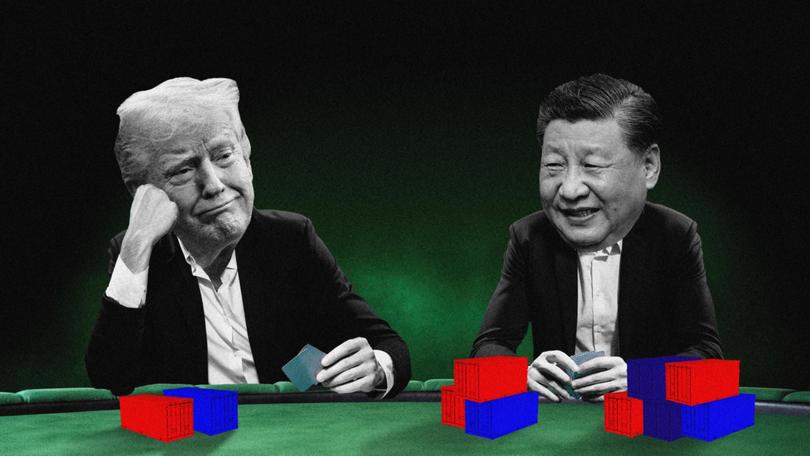JACKSON HEWETT: Donald Trump makes a meal out of the art of the deal

Negotiating by pointing a shotgun at your own toes was never going to end well.
Four months into the “golden age” Trump promised to usher in by clipping the ticket on imports sold to American consumers, the capitulation is nearly complete.
In the hours following ‘Liberation Day’, the Trump administration was warning countries there would be no turning back from America’s punitive tariffs.
Sign up to The Nightly's newsletters.
Get the first look at the digital newspaper, curated daily stories and breaking headlines delivered to your inbox.
By continuing you agree to our Terms and Privacy Policy.“My advice to every country right now is, do not retaliate. Sit back, take it in, see how it goes, because if you retaliate, there will be escalation,” Treasury Secretary Scott Bessent said.
Tariffs escalated as high as 145 per cent on the American side and 125 per cent on China’s.
Now, for 90 days at least, tariffs are back down to the 10 per cent global baseline, plus the 20 per cent still levied on China to force it to stop the fentanyl trade. Tariffs on Chinese steel and autos will remain in force.
It’s hard to imagine the US reinstating those tariffs, given the massive upheaval they caused to the economy, with countless hours of social media and press coverage detailing the devastation for millions of businesses reliant on Chinese imports.
The episode has also exposed a serious weakness in the US economy, and perhaps in the administration itself.
Trump’s trade adviser Peter Navarro had envisioned tariffs triggering a great reshoring of US manufacturing, rebuilding the industrial base to the strength of the World War II era.
That vision is now untenable. It would be economic madness for any company to make long-term investments in US production under such a capricious regime.
It also puts a serious dent in the ‘Art of the Deal’ reputation.
As one wag in the Wall Street Journal commented: “I thought this was 4D chess. More like 1D checkers!”
China also comes out of this remarkably well. President Xi Jinping refused to give in to US demands, ignoring repeated requests to take Trump’s calls.
China has been preparing for a shift in global trade since Trump’s first term, building self-sufficiency and shoring up its financial system. The country’s manufacturers were certainly feeling the pain, with exporters seeing the biggest drop in orders since COVID. But unlike in the US, where Federal Reserve Chairman Jerome Powell refused to cut interest rates for fear of inflation, China’s government controls the financial levers. It responded by cutting rates and pumping nearly $US300 billion into the economy.
“We’ve seen pretty clearly now that the Trump administration has recognised that there are limits on what it can do and that it doesn’t actually hold all the cards – China holds a lot of cards,” said Dr Jenny Gordon, Nonresident Fellow at the Lowy Institute and former chief economist at the Department of Foreign Affairs and Trade.
The move will also constrain US efforts to isolate China from the global community.
“If the US is backing down on what it’s done to China, it’s going to be much harder for them to argue that other countries should put tariffs on China or isolate China.”
For Australia, a resurgent China is a positive sign. The country accounts for more than 8 per cent of Australia’s GDP, and any slowdown there would affect the tax receipts that underpin a significant portion of the Federal Budget.
Treasurer Jim Chalmers described the US backdown as encouraging, but warned that the situation remained unpredictable.
“Australia’s got a lot to lose from a trade war between the US and China in particular, and so we want to see these trade tensions de-escalated permanently, not temporarily,” he told ABC Radio National. “There has been a lot of unpredictability from day to day … we welcome the announcement over the last day or so, but we’re not getting carried away by it.”
Dr Gordon said it was too soon to expect tariff relief for Australian companies exporting to the US, who still face a 10 per cent tariff and 25 per cent on steel and aluminium, despite the US and Australia having a free trade agreement.
She said the 10 per cent global tariff was likely to remain, as it still applied even after a carve-out was granted for the UK. However, there were good prospects for Australian steel and aluminium, given that tariff was slashed to zero for British exporters.
Australian exports to the US are relatively small – less than 1 per cent of GDP – with aluminium and steel exports valued at under $1 billion. That may put Australia toward the back of the queue, as other countries double down on negotiations following the US-China pause.
“I don’t think we come high up in the pecking order of interest,” Dr Gordon said.
Markets soar
Investors greeted the news with full-throated optimism, with US shares jumping 3 per cent and the tech-heavy NASDAQ climbing more than 4 per cent.
Australian companies with US exposure surged in early trade. 4WD parts maker ARB rose more than 5 per cent, tracking software firm Life360 jumped 12 per cent, and WiseTech was up more than 5 per cent.
Breville, which manufactures coffee machines and other homeware products in China and across Asia, also took off, rising more than 8 per cent in morning trade.
The numbers don’t lie
Tariffs were supposed to be the big revenue driver for a new age in America, one that offered tax cuts while getting down a budget deficit that is rapidly running out of control.
The problem was the logic was flawed.
One of Australia’s top economists, former Reserve Bank board member Warwick McKibbin crunched the numbers and found that a 15 per cent tariff would be revenue positive to the tune of $US3.9 trillion over a decade.
But factor in other countries retaliating and the effect of a domestic economic slowdown, and the revenue falls to $US1.5t. Under a scenario of a 20 per cent tariff, the benefit falls to just shy of $800b. Big biccies sure, but not going to put too much of a dent in the huge and growing US budget deficit which is expected to top $US1.9t this financial year.
Tax cuts are still on the cards to the tune of $US5.3t, all which will have to be financed by debt. On top of that throw an additional $US520b on defence.
The massive mismatch between US spending and revenue is not being addressed through proper reform and DOGE savings seem to be receding as fast as Tesla sales.
That’s why amidst all the share-market exuberance the elephant in the room is the bond market. Bond traders continue to push up US interest rates as they wonder just when a “deal” can be made on getting US debt under control.

